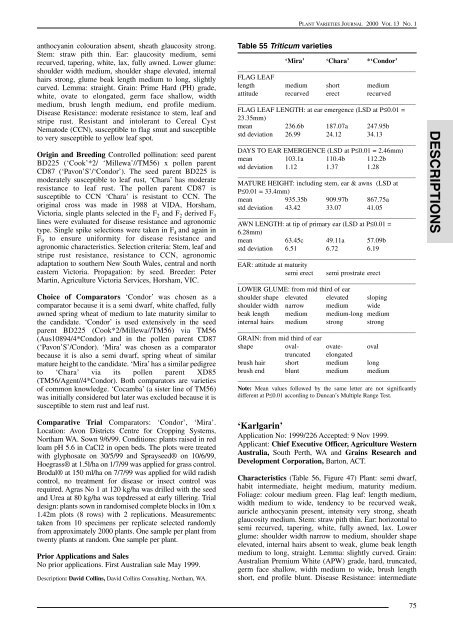53. Volume 13- Number 1 - IP Australia
53. Volume 13- Number 1 - IP Australia
53. Volume 13- Number 1 - IP Australia
You also want an ePaper? Increase the reach of your titles
YUMPU automatically turns print PDFs into web optimized ePapers that Google loves.
DESCR<strong>IP</strong>TIONS<br />
PLANT VARIETIES JOURNAL 2000 VOL <strong>13</strong> NO. 1<br />
anthocyanin colouration absent, sheath glaucosity strong.<br />
Stem: straw pith thin. Ear: glaucosity medium, semi<br />
recurved, tapering, white, lax, fully awned. Lower glume:<br />
shoulder width medium, shoulder shape elevated, internal<br />
hairs strong, glume beak length medium to long, slightly<br />
curved. Lemma: straight. Grain: Prime Hard (PH) grade,<br />
white, ovate to elongated, germ face shallow, width<br />
medium, brush length medium, end profile medium.<br />
Disease Resistance: moderate resistance to stem, leaf and<br />
stripe rust. Resistant and intolerant to Cereal Cyst<br />
Nematode (CCN), susceptible to flag smut and susceptible<br />
to very susceptible to yellow leaf spot.<br />
Origin and Breeding Controlled pollination: seed parent<br />
BD225 (‘Cook’*2/ ‘Millewa’//TM56) x pollen parent<br />
CD87 (‘Pavon’S’/‘Condor’). The seed parent BD225 is<br />
moderately susceptible to leaf rust, ‘Chara’ has moderate<br />
resistance to leaf rust. The pollen parent CD87 is<br />
susceptible to CCN ‘Chara’ is resistant to CCN. The<br />
original cross was made in 1988 at VIDA, Horsham,<br />
Victoria, single plants selected in the F 2 and F 2 derived F 3<br />
lines were evaluated for disease resistance and agronomic<br />
type. Single spike selections were taken in F 4 and again in<br />
F 9 to ensure uniformity for disease resistance and<br />
agronomic characteristics. Selection criteria: Stem, leaf and<br />
stripe rust resistance, resistance to CCN, agronomic<br />
adaptation to southern New South Wales, central and north<br />
eastern Victoria. Propagation: by seed. Breeder: Peter<br />
Martin, Agriculture Victoria Services, Horsham, VIC.<br />
Choice of Comparators ‘Condor’ was chosen as a<br />
comparator because it is a semi dwarf, white chaffed, fully<br />
awned spring wheat of medium to late maturity similar to<br />
the candidate. ‘Condor’ is used extensively in the seed<br />
parent BD225 (Cook*2/Millewa//TM56) via TM56<br />
(Aus10894/4*Condor) and in the pollen parent CD87<br />
(‘Pavon’S’/Condor). ‘Mira’ was chosen as a comparator<br />
because it is also a semi dwarf, spring wheat of similar<br />
mature height to the candidate. ‘Mira’ has a similar pedigree<br />
to ‘Chara’ via its pollen parent XD85<br />
(TM56/Agent//4*Condor). Both comparators are varieties<br />
of common knowledge. ‘Cocamba’ (a sister line of TM56)<br />
was initially considered but later was excluded because it is<br />
susceptible to stem rust and leaf rust.<br />
Comparative Trial Comparators: ‘Condor’, ‘Mira’.<br />
Location: Avon Districts Centre for Cropping Systems,<br />
Northam WA. Sown 9/6/99. Conditions: plants raised in red<br />
loam pH 5.6 in CaCl2 in open beds. The plots were treated<br />
with glyphosate on 30/5/99 and Sprayseed® on 10/6/99,<br />
Hoegrass® at 1.5l/ha on 1/7/99 was applied for grass control.<br />
Brodal® at 150 ml/ha on 7/7/99 was applied for wild radish<br />
control, no treatment for disease or insect control was<br />
required. Agras No 1 at 120 kg/ha was drilled with the seed<br />
and Urea at 80 kg/ha was topdressed at early tillering. Trial<br />
design: plants sown in randomised complete blocks in 10m x<br />
1.42m plots (8 rows) with 2 replications. Measurements:<br />
taken from 10 specimens per replicate selected randomly<br />
from approximately 2000 plants. One sample per plant from<br />
twenty plants at random. One sample per plant.<br />
Prior Applications and Sales<br />
No prior applications. First <strong>Australia</strong>n sale May 1999.<br />
Description: David Collins, David Collins Consulting, Northam, WA.<br />
Table 55 Triticum varieties<br />
‘Mira’ ‘Chara’ *‘Condor’<br />
____________________________________________________<br />
FLAG LEAF<br />
length medium short medium<br />
attitude recurved erect recurved<br />
____________________________________________________<br />
FLAG LEAF LENGTH: at ear emergence (LSD at P≤0.01 =<br />
23.35mm)<br />
mean 236.6b 187.07a 247.95b<br />
std deviation 26.99 24.12 34.<strong>13</strong><br />
____________________________________________________<br />
DAYS TO EAR EMERGENCE (LSD at P≤0.01 = 2.46mm)<br />
mean 103.1a 110.4b 112.2b<br />
std deviation 1.12 1.37 1.28<br />
____________________________________________________<br />
MATURE HEIGHT: including stem, ear & awns (LSD at<br />
P≤0.01 = 33.4mm)<br />
mean 935.35b 909.97b 867.75a<br />
std deviation 43.42 33.07 41.05<br />
____________________________________________________<br />
AWN LENGTH: at tip of primary ear (LSD at P≤0.01 =<br />
6.28mm)<br />
mean 63.45c 49.11a 57.09b<br />
std deviation 6.51 6.72 6.19<br />
____________________________________________________<br />
EAR: attitude at maturity<br />
semi erect semi prostrate erect<br />
____________________________________________________<br />
LOWER GLUME: from mid third of ear<br />
shoulder shape elevated elevated sloping<br />
shoulder width narrow medium wide<br />
beak length medium medium-long medium<br />
internal hairs medium strong strong<br />
____________________________________________________<br />
GRAIN: from mid third of ear<br />
shape oval- ovate- oval<br />
truncated elongated<br />
brush hair short medium long<br />
brush end blunt medium medium<br />
____________________________________________________<br />
Note: Mean values followed by the same letter are not significantly<br />
different at P≤0.01 according to Duncan’s Multiple Range Test.<br />
‘Karlgarin’<br />
Application No: 1999/226 Accepted: 9 Nov 1999.<br />
Applicant: Chief Executive Officer, Agriculture Western<br />
<strong>Australia</strong>, South Perth, WA and Grains Research and<br />
Development Corporation, Barton, ACT.<br />
Characteristics (Table 56, Figure 47) Plant: semi dwarf,<br />
habit intermediate, height medium, maturity medium.<br />
Foliage: colour medium green. Flag leaf: length medium,<br />
width medium to wide, tendency to be recurved weak,<br />
auricle anthocyanin present, intensity very strong, sheath<br />
glaucosity medium. Stem: straw pith thin. Ear: horizontal to<br />
semi recurved, tapering, white, fully awned, lax. Lower<br />
glume: shoulder width narrow to medium, shoulder shape<br />
elevated, internal hairs absent to weak, glume beak length<br />
medium to long, straight. Lemma: slightly curved. Grain:<br />
<strong>Australia</strong>n Premium White (APW) grade, hard, truncated,<br />
germ face shallow, width medium to wide, brush length<br />
short, end profile blunt. Disease Resistance: intermediate<br />
75

















